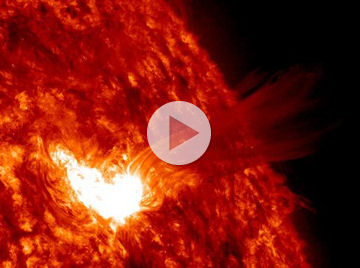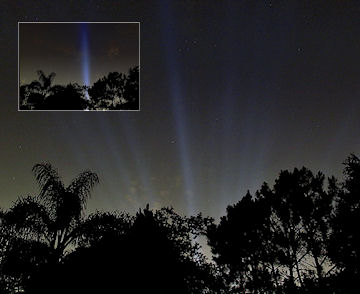NEW AND IMPROVED: Turn your iPhone or iPod Touch into a field-tested global satellite tracker. The Satellite Flybys app now works in all countries. | | | WELCOME HOME, HAYABUSA: Japan's Hayabusa spacecraft returned to Earth today carrying samples of asteroid Itokawa. The sample return capsule parachuted to Earth somewhere in Australia's Woomera Test Range (searchers are looking for it now) while the mothership disintegrated in the atmosphere high above ground. Update: NASA's DC-8 flying laboratory was in the air over Australia to record the reentry. Researchers have just released a must-see video. SOLAR FLARE UPDATE: Sunspot 1079 near the sun's southwestern limb has joined this weekend's flare show (described below) with a series of its own M- and C-class eruptions. Click here for an SDO movie entitled "Blowing Bubbles." SOLAR FLARES: Sunspot 1081 is crackling with C- and M-class solar flares. Here is a picturesque C6-category blast recorded yesterday, June 12th (0917 UT), by NASA's Solar Dynamics Observatory (SDO): 
[still frame] [movies: 1.6 MB mpeg; 1.3 MB iPad; 0.6 MB iPhone]
An even stronger M2-class flare on June 12th (0055 UT) sparked a bright flash of extreme ultraviolet radiation, propelled a shock wave through the sun's atmosphere, and hurled a billion-ton coronal mass ejection (CME) into space. The CME is expected to miss Earth--so no auroras. The M-flare also produced a Type II radio burst. "Although the sun was setting here in New Mexico, I was able to record the burst at 28 MHz and 24 MHz," says amateur radio astronomer Thomas Ashcraft. "Here is an audio file. The slow swoosh you just heard is radio noise from the sun!" Another radio astronomer, Dick Flagg of Hawaii, used a radio spectrograph at Windward Community College in Oahu to record the burst's dynamic spectrum. Sunspot 1081 appears to be in a state of slight decay, but that has not stopped the flares. Indeed, the decay may be contributing to magnetic instabilities underlying these explosions. Readers with solar telescopes are encouraged to monitor developments. more images: from Cai-Uso Wohler of Bispingen, Germany; from David Evans of Coleshill, North Warwickshire, UK; from Alan Friedman of downtown Buffalo, NY; from Pavol.Rapavy of Observatory Rimavska Sobota, Slovakia; from Michael Borman of Evansville, Indiana; from Guenter Kleinschuster of Feldbach, Styria, Austria THE END OF ASTRONOMY IN ORLANDO: "Universal Studios is about to open a brand new Harry Potter ride in one week," reports amateur astronomer Brent from Orlando, Florida. "The new spotlight they have for it is ... Riddikulus!!" He took this picture of the night sky on June 12th with the spotlight in action: 
"The beam splits and dances over the entire sky," he laments. "I'm going to have to take up a new hobby." Brent took this picture of Comet McNaught through a brief gap in the beams. Compare that to what is possible without a spotlight. More information about the perils and problems of urban light pollution is available from the International Dark Sky Association. Also, please consider purchasing night sky-friendly lighting from Spaceweather.com supporter Starry Night Lights.
May 2010 Aurora Gallery
[previous Mays: 2008, 2005, 2004, 2003, 2002] [aurora alerts] | 
